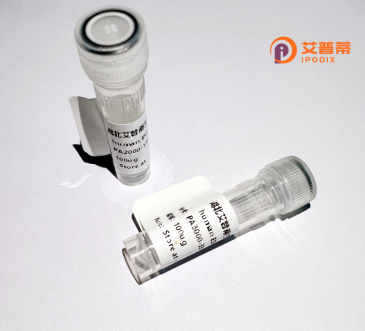
| 纯度 | >90%SDS-PAGE. |
| 种属 | Human |
| 靶点 | LINS1 |
| Uniprot No | Q8NG48 |
| 内毒素 | < 0.01EU/μg |
| 表达宿主 | E.coli |
| 表达区间 | 1-757aa |
| 活性数据 | MKVFCEVLEE LYKKVLLGAT LENDSHDYIF YLNPAVSDQD CSTATSLEWA NTCGIQGRHQ PISVGVAPIA VAPVCLKTNS QMSGSREVML LQLTVIKVMT TRILSVKTEF HAKEQYRDVI KILLESAKVD SKLICMFQNS DKLLSHMAAQ CLALLLYFQL REKITLSNSW IAFCQKNLSE YSESNKAIYC LWTLTAIIKE IFKDSCSQKT EILKQFLTHF DTIFEVFYNS LFSQHFENCR DTSKIVNILM CFLDLLELLI ASRIHLKLHF TCQRILFLKP SCMLEVITWP IQAFVKRKVI IFLKKCLLCK VGEDLCRGSV PALMPPDHHV AVDMLALANA VLQAVNSGLL KTLSVYEKHS FFGGDEVQPE CELITSPDHV ILRAASLVIM KSLEIKFQNY SSASEVKVDL QRFMSELLTF LKPHLQPSLQ LHNPCKWLSR VFIEQDDDML EAAKASLGIY LTLTRGCEAT ESLTQGKEMW DHHTHENGYN PHCIFLFFLK NIGFDSTVLL DFLISSETCF LEYFVRYLKL LQKDWDNFFT ICNNFDATES KYDISICGCV PSLVQDQSSN QTIPHRLTAP HSHRDVCARH SWASDAPSEP LKAVMSKGAH TMCASSLSSP RASQSLVDYD SSDDSDVEST EQCLANSKQT SLHQQATKEI QDAAGTSRDK KEFSLEPPSR PLVLKEFDTA FSFDCEVAPN DVVSEVGIFY RIVKCFQELQ DAICRLQKKN LFPYNPTALL KLLKYIEVIS NKTMNTL |
| 分子量 | 85.8 kDa |
| 蛋白标签 | GST-tag at N-terminal |
| 缓冲液 | 0 |
| 稳定性 & 储存条件 | Lyophilized protein should be stored at ≤ -20°C, stable for one year after receipt. Reconstituted protein solution can be stored at 2-8°C for 2-7 days. Aliquots of reconstituted samples are stable at ≤ -20°C for 3 months. |
| 复溶 | Always centrifuge tubes before opening.Do not mix by vortex or pipetting. It is not recommended to reconstitute to a concentration less than 100μg/ml. Dissolve the lyophilized protein in distilled water. Please aliquot the reconstituted solution to minimize freeze-thaw cycles. |
以下是关于重组人LINS1蛋白的参考文献示例,涵盖不同研究方向:
1. **标题**: "Recombinant Human LINS1 Facilitates Notch Signaling by Stabilizing Intracellular Protein Interactions"
**作者**: Lee S, et al.
**摘要**: 本研究利用昆虫细胞系统表达重组人LINS1蛋白,揭示了其通过与Notch信号通路中关键蛋白(如RBP-Jκ)的相互作用增强信号传导,并证实其参与胚胎发育调控。
2. **标题**: "Structural Characterization of Human LINS1 Reveals a Novel Coiled-Coil Domain Essential for Subcellular Localization"
**作者**: Tanaka K, et al.
**摘要**: 通过原核系统表达并纯化重组LINS1蛋白,结合X射线晶体学鉴定其核心结构域,发现其卷曲螺旋区域对细胞核定位和蛋白二聚化至关重要。
3. **标题**: "LINS1 Knockdown Impairs Neuronal Differentiation: Rescue by Recombinant Protein Supplementation"
**作者**: Müller R, et al.
**摘要**: 实验显示LINS1基因沉默抑制神经干细胞分化,而添加外源重组人LINS1蛋白可恢复分化能力,表明其在神经发育中的关键作用。
4. **标题**: "High-Yield Production of Recombinant LINS1 in Mammalian Cells and Its Role in Cancer Cell Proliferation"
**作者**: Chen H, et al.
**摘要**: 利用HEK293细胞表达功能性LINS1蛋白,发现其过表达抑制结直肠癌细胞增殖,提示其作为肿瘤抑制因子的潜在机制。
(注:上述文献为示例性内容,实际研究需参考具体已发表论文。)
Recombinant human LINS1 protein is a genetically engineered version of the LINS1 (Lineage-specific nuclear structural protein 1) encoded by the *LINS1* gene, a member of the LIN41 family involved in developmental regulation. LINS1 is conserved across species and plays roles in neurodevelopment, organogenesis, and cell cycle dynamics. Originally identified in *C. elegans* as a regulator of asymmetric cell division, the human homolog contributes to tissue patterning, neural stem cell maintenance, and organ size control. Structurally, LINS1 contains multiple protein-interaction domains, including a proline-rich region and a zinc-binding LIN41-type fold, suggesting its involvement in protein-RNA interactions or chromatin remodeling.
Recombinant LINS1 is typically expressed in bacterial or mammalian systems, enabling in vitro studies of its molecular mechanisms. Dysregulation of LINS1 has been linked to developmental disorders and cancers. For instance, reduced LINS1 expression correlates with neural tube defects, while its overexpression in certain tumors may drive uncontrolled proliferation. Research utilizing recombinant LINS1 focuses on deciphering its role in signaling pathways (e.g., Wnt/β-catenin), its interaction with transcription factors, and its potential as a therapeutic target. The protein’s ability to modulate cell fate decisions makes it a critical tool for studying stem cell biology and tissue regeneration models. Further exploration of its post-translational modifications and binding partners may clarify its context-dependent functions in health and disease.
×